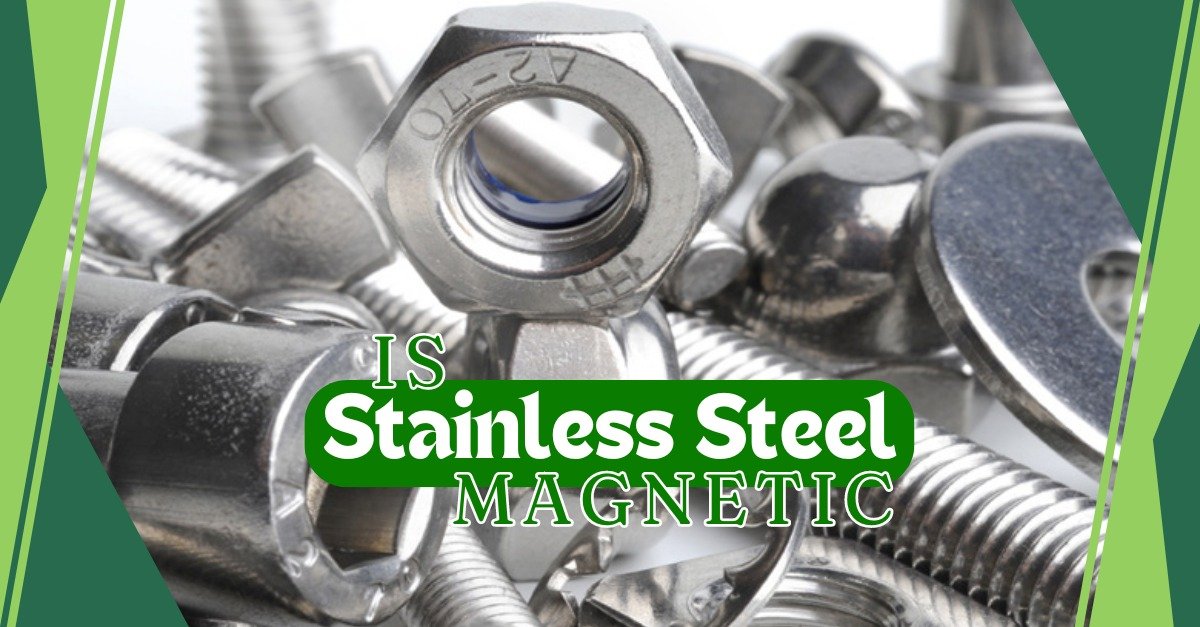Stainless steel is a commonly used material in everyday life, especially in kitchen appliances, medical equipment, and construction. Its durability, corrosion resistance, and sleek appearance make it a popular choice. However, a frequent question that comes up is: is stainless steel magnetic? Understanding the magnetic properties of stainless steel can help in applications where magnetism is important, such as in certain machinery or even in household items like refrigerator magnets.
Do Magnets Stick to Stainless Steel?
The short answer to this question is both yes and no, depending on the type of stainless steel. Stainless steel is a group of iron-based alloys, and some types of stainless steel exhibit magnetic properties while others do not. The reason behind this difference is the crystal structure of the steel, which changes depending on the alloy composition.
There are various grades of stainless steel, but the most commonly used ones are 304 and 316 stainless steel, and their magnetic properties vary. For example, 304 stainless steel is considered non-magnetic in its annealed state, while ferritic stainless steel like 430 stainless steel is magnetic. The difference lies in the microstructure of these alloys.
Ferritic stainless steel, which has a body-centered cubic structure, allows magnets to stick because the steel contains iron and very little nickel. On the other hand, austenitic stainless steel, such as 304 and 316, has a face-centered cubic structure that makes it non-magnetic in most situations. So, if you’re asking, “do magnets stick to stainless steel?” the answer depends on the grade of the steel in question.
Why Won’t My Magnets Stick to Stainless Steel?
One common confusion arises when magnets won’t stick to certain types of stainless steel, even though the material contains iron, which is a magnetic metal. The reason for this is the austenitic crystal structure found in stainless steel grades such as 304 and 316. This structure is non-magnetic and results from the high amounts of nickel and chromium present in the alloy. These elements change the atomic arrangement in such a way that the magnetic fields from the iron are canceled out.
If you have a refrigerator or a kitchen appliance made from 304 stainless steel, you may notice that magnets won’t stick to it. This can be surprising, especially since we associate steel with being magnetic. To test this, you could use a small magnet on various stainless steel objects around the house, and you’ll likely notice that only some of them allow magnets to adhere.
Another factor that can influence the magnetism of stainless steel is the cold working process. In some cases, cold-working the metal can make non-magnetic stainless steel become magnetic. This is because the mechanical deformation alters the crystal structure, enabling the steel to exhibit some magnetic properties.
Which Type of Steel Is the Most Magnetic?
When comparing different types of steel, ferritic and martensitic stainless steels are the most magnetic. Among these, 430 stainless steel is one of the most magnetic types. This is because it has a high concentration of iron and lacks the nickel that typically suppresses magnetism in austenitic grades. Ferritic stainless steels are commonly used in applications where both corrosion resistance and magnetism are needed, such as in automotive parts, industrial machinery, and some household items.
Martensitic stainless steel, like 410 stainless steel, is also magnetic and is known for its hardness. This type of stainless steel is often used in making knives, surgical instruments, and cutting tools. The higher carbon content in martensitic steel allows it to be hardened and tempered, which makes it useful in industries where strength is critical.
In contrast, austenitic stainless steel, such as 304 and 316, is less likely to be magnetic. The addition of nickel in austenitic steels changes their structure and renders them largely non-magnetic, though they can become slightly magnetic when cold-worked. This makes them ideal for applications requiring both corrosion resistance and non-magnetic properties, such as in marine environments and medical equipment.
Understanding the Magnetic Properties of Stainless Steel
The magnetism of stainless steel is primarily determined by its crystal structure and alloy composition. As mentioned earlier, the two most common types of stainless steel – austenitic and ferritic – have different magnetic properties. Austenitic stainless steel (like 304 and 316) contains significant amounts of chromium and nickel, which changes its internal structure and makes it non-magnetic. Ferritic stainless steel (such as 430) contains iron but lacks nickel, allowing it to maintain its magnetic properties.
In general, stainless steel’s magnetic properties can be understood through the concept of ferromagnetism. Ferromagnetic materials, like iron and some types of stainless steel, have magnetic domains that can align in the presence of a magnetic field, allowing them to attract magnets. When nickel is added to stainless steel, however, it alters the alignment of these magnetic domains, reducing or eliminating the material’s magnetism.
Is Surgical Stainless Steel Magnetic?
When it comes to surgical stainless steel, the question of magnetism becomes more complex. Surgical stainless steel is often made from 316 stainless steel, which is a type of austenitic stainless steel. This means that surgical stainless steel is generally non-magnetic due to its high chromium and nickel content. However, like other forms of austenitic steel, it may become slightly magnetic if subjected to extensive cold working or mechanical stress during manufacturing.
Surgical-grade stainless steel needs to be both corrosion-resistant and biocompatible, meaning it won’t react negatively with the human body. The non-magnetic nature of surgical stainless steel is an important property, especially in medical settings where magnetic fields, such as in MRI machines, are frequently used. Non-magnetic surgical instruments reduce the risk of interference with sensitive medical equipment.
Types of Stainless Steel: Magnetic vs Non-Magnetic
The differences between magnetic and non-magnetic stainless steel come down to the alloy’s composition and crystal structure. Magnetic stainless steels are typically ferritic or martensitic, containing higher amounts of iron and lower amounts of nickel. These steels are used in applications where magnetism is a desired property, such as in electrical devices, motor parts, and decorative features.
Non-magnetic stainless steels, on the other hand, are austenitic and contain more nickel, which disrupts the iron’s magnetic fields. These steels are ideal for applications where corrosion resistance is more important than magnetism, such as in food processing, pharmaceuticals, and marine environments.
304 vs 316 Stainless Steel: Which Is More Magnetic?
The two most popular grades of stainless steel are 304 and 316, both of which are austenitic. In their standard form, neither of these grades is magnetic. However, 304 stainless steel can become slightly magnetic when cold-worked, while 316 remains mostly non-magnetic even after extensive processing.
The key difference between the two is that 316 stainless steel contains molybdenum, which gives it greater resistance to corrosion. This is why 316 stainless steel is commonly used in harsh environments, such as in marine and chemical industries. 304 stainless steel is more affordable but slightly less resistant to corrosion. Both grades are excellent choices for applications that require non-magnetic properties, but 316 is generally preferred in more extreme conditions.
Conclusion
In conclusion, the magnetism of stainless steel depends largely on its alloy composition and crystal structure. While ferritic and martensitic stainless steels are magnetic, austenitic stainless steels like 304 and 316 are typically non-magnetic. The presence of nickel and chromium in the alloy plays a significant role in determining whether the steel will attract magnets. Additionally, factors like cold working can sometimes make non-magnetic stainless steel slightly magnetic.
Understanding these properties can help you choose the right type of stainless steel for your needs, whether you’re looking for magnetic properties or corrosion resistance.
FAQs
Does magnetism affect the quality of stainless steel?
No, magnetism does not affect the quality, durability, or corrosion resistance of stainless steel.
Can you magnetize stainless steel?
Austenitic stainless steels (like 304 and 316) are usually non-magnetic but can become slightly magnetic after cold working. Ferritic and martensitic stainless steels are naturally magnetic.
Is food-grade stainless steel magnetic?
Food-grade stainless steel (e.g., 304) is generally non-magnetic, but slight magnetism may develop after certain processes without affecting its use in food applications.
How does temperature affect stainless steel magnetism?
Temperature has minimal effect on magnetism in normal conditions, but high temperatures can reduce magnetism in ferritic stainless steel.
Can magnets damage stainless steel appliances?
Magnets do not damage stainless steel but may cause minor scratches if dragged across the surface.
Why is some stainless steel magnetic and others not?
Stainless steel’s magnetism depends on its structure. Austenitic steels are non-magnetic, while ferritic and martensitic steels are magnetic due to their atomic arrangement.

Evelyn White is an experienced content writer with a background in lifestyle, trends, and practical advice. With several years of writing across digital platforms, she specializes in making everyday topics accessible, informative, and engaging. Her goal is to deliver trustworthy, reader-focused content that’s both useful and easy to understand.
Discover more from Try Hard Guides
Subscribe to get the latest posts sent to your email.

